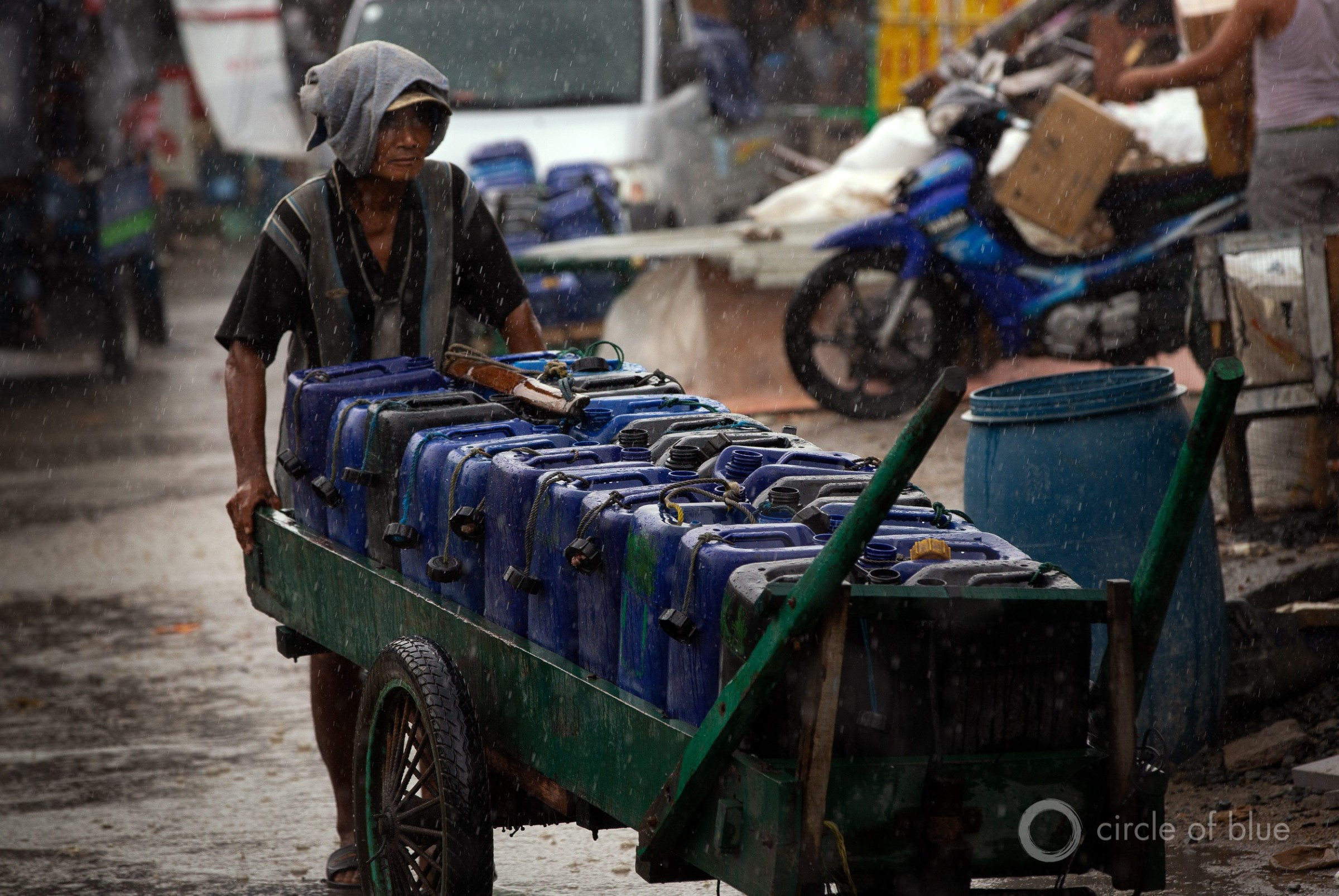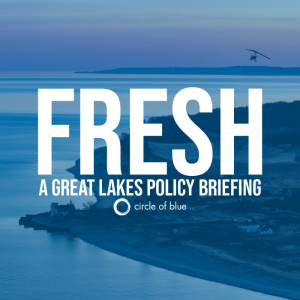Global water challenges headline gathering in New York City this week.

Ujang delivers water to customers in the poor neighborhoods of North Jakarta. His cart is a crucial supply line to communities beset by water insecurity. © J. Carl Ganter / Circle of Blue
By Brett Walton, Circle of Blue – March 20, 2023
The last time the United Nations hosted a conference dedicated to global water supply and sanitation the world looked vastly different. Half as many people were alive. China’s economy was smaller than the United Kingdom’s. And a year colder than the 20th century average was still possible.
It was 1977, a decade of global environmental awakening, when the nations of the world gathered in an Argentine port city to call attention to the vulnerability of water bodies to pollution and overuse. The Mar del Plata conference aimed for wiser management of an essential resource in order to improve environmental health and “promote human dignity and happiness.”
Forty-six years later, the challenges remain. Environmental health and human dignity are again on the agenda. But achieving progress is impeded by growth in farm and factory output and by a warming planet that is unleashing hellacious droughts, ruinous floods, and punishing storms. Industrial farms gulp water and spit out pollutants. Glaciers from the Alps to the Andes are shriveling, drying out alpine towns.
Delegates arriving this week in New York City to take part in the UN’s second international water conference will do so in more frenzied circumstances. Eight billion people now inhabit the planet. China, hoovering raw materials for decades, is the world’s second largest economy, its output more than five times bigger than the UK’s. And global temperatures march steadily upwards.
“The world is a much riskier place than in 1977,” said Quentin Grafton, a water scholar at the Australian National University.
Part pep rally, part trade show, part performance review, the UN Water Conference is pitched by its co-hosts, the governments of the Netherlands and Tajikistan, as an opportunity for the world to recommit to ambitious goals of safely managed water and sanitation for all people and ecosystems.
The centerpiece of the conference, which runs from March 22 to 24, is the “water action agenda,” a compilation of voluntary commitments from national governments, nonprofits, businesses, and intergovernmental agencies. Together these commitments extend beyond the conference walls, pushing leaders to be more careful, inclusive water stewards in the years ahead.
“It’s not what happens in three days,” Grafton said about the goals of the conference. “It’s what happens afterward.”
Immediate changes are unlikely. It is not the Bretton Woods conference, the post-World War Two assembly that established the World Bank and International Monetary Fund, thereby reconstructing the global financial system. It is not the 1992 Rio Earth Summit, which resulted in UN conventions on three major environmental issues: biodiversity, climate change, and desertification.
The water conference is more akin to the 1972 UN Conference on the Environment, which, in a form of soft power, elevated the health of the world’s ecosystems to a place of international prominence.
The legacy of the water conference will be more piecemeal than its landmark predecessors, its success determined by the dedication of national governments, businesses, financial institutions, and nonprofits to carry out their commitments. More than 90 government ministers and eight presidents or prime ministers are scheduled to attend the conference.
“The political dimension is a huge part of the solution to the water crisis,” said Federico Properzi, chief technical adviser of UN-Water.
Reducing carbon emissions would relieve the mounting pressure of weather extremes. But because negotiations over emissions reductions take place elsewhere, the conference will instead emphasize ways to adapt to a fevered planet.
Marisa Escobar of the Stockholm Environment Institute works on watershed management in basins across the globe. Many areas struggle to pay for adaptation projects. More financing options and assistance would help, she said.
The action agenda commitments display the breadth and depth of the world’s water challenges. Some of the 419 commitments submitted through Sunday are strikingly local and contained. The nonprofit group ASDD intends to reforest the banks of Burundi’s Mugere River to prevent erosion. Stora Enso Oyj, a Finnish wood products company, pledges to reduce its wastewater discharge.
These benefits are welcomed in their place, but the conference is not centered on a series of small steps. Organizers are looking for big “game changer” commitments that will alter the trajectory of water governance and use.
Charles Iceland of the World Resources Institute is tracking the commitments. He said that game changers will be those supported by money or political power, or those that can be applied at scale, across multiple areas.
“They have a lot of money behind them, or they have big entities behind them that have produced good outcomes in the past,” Iceland said.
Getting Back on Track
The conference is taking place at the midpoint of two UN initiatives. One is rather obscure: the International Decade for Action on Water for Sustainable Development. The other is the driving force for global poverty-reduction efforts: the Sustainable Development Goals (SDGs), which have a 2030 deadline.
There have been undoubted successes for water and sanitation. Billions more people today have access to safe drinking water than two decades ago. But the failures are just as glaring. As of 2020, about 2 billion people do not have safely managed drinking water. Even more people lack the same level of sanitation service. Wetlands are under constant threat of destruction and water withdrawals from rivers and aquifers are, in many areas, unsustainable.
“We can’t continue that track for another 46 years,” said Grafton, who co-authored a review of progress and shortfalls for water since Mar del Plata. In short, many of the issues that were then identified as priorities — data collection, pollution management, wetlands protection — remain unresolved.
Chasms exist between countries. Whereas most North Americans and Europeans have high-quality piped water service, fewer than three in 10 Africans enjoy the same comforts. Differences within countries can be just as stark. Urban dwellers are more connected than their rural counterparts.
Though the UN Environment Program says that more water resources data is being collected, gaps identified in 1977 persist. Many countries still do not regularly monitor key indicators like water quality in rivers and lakes, access to sanitation, and the effectiveness of wastewater treatment.
This adds up to the world being far removed from its intended track. According to the UN, progress needs to accelerate four-fold if the ambitious SDGs for water, sanitation, and hygiene are to be achieved by 2030.
Will the water conference change the course? The schedule is stuffed to the point of claustrophobia. UN climate conventions unfold across two weeks of negotiations, panel discussions, and dialogues. The water conference, by contrast, is packed into three days. Official presentations take place in the UN General Assembly. But the program of side events taking place within the UN complex unfolds across 32 pages. The side events at locations elsewhere in New York take up 62 pages.
The atmosphere of swirling possibility is part of the appeal. Attention is a form of power, and conference organizers and observers hope that a short period of intense focus can be the spark to rally national governments and financial institutions to take on the big challenges of water for years to come.
“To keep it alive we have to keep reaching out to these actors and seeing how they’re progressing and trying to keep them accountable,” Iceland said. “So it’s not just a laundry list and collects dust in future years.”
Brett writes about agriculture, energy, infrastructure, and the politics and economics of water in the United States. He also writes the Federal Water Tap, Circle of Blue’s weekly digest of U.S. government water news. He is the winner of two Society of Environmental Journalists reporting awards, one of the top honors in American environmental journalism: first place for explanatory reporting for a series on septic system pollution in the United States(2016) and third place for beat reporting in a small market (2014). He received the Sierra Club’s Distinguished Service Award in 2018. Brett lives in Seattle, where he hikes the mountains and bakes pies. Contact Brett Walton





